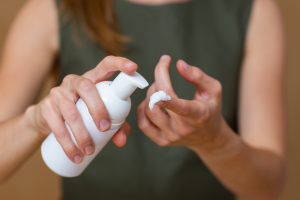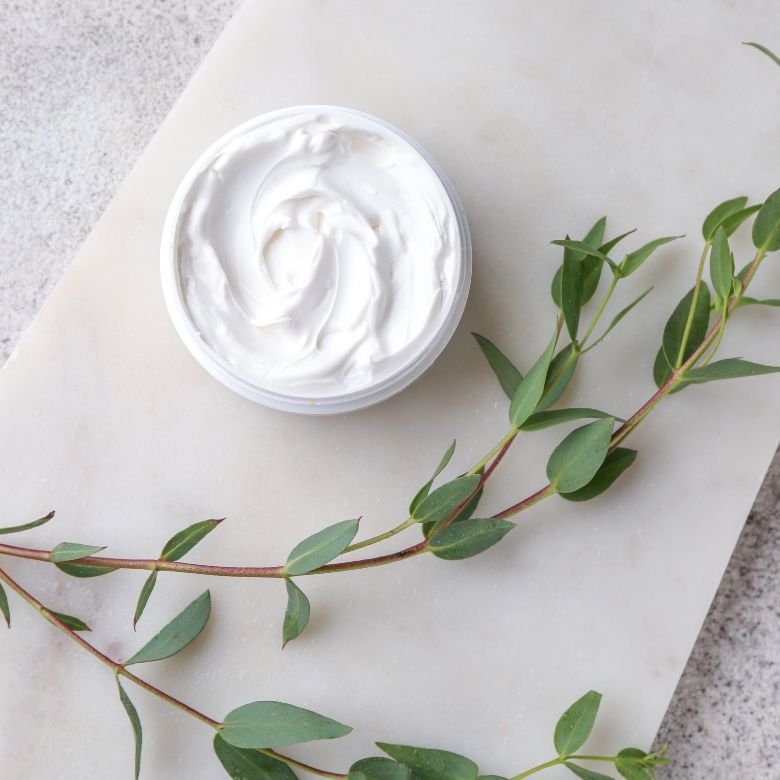The range of skincare products for the face, body and hair is extremely broad today. Chemists' shelves are crammed with a variety of preparations, leaving many people struggling to make purchasing decisions. Unfortunately, not every product may be right for you, so it's a good idea to find out its properties, read the ingredients and consider your own needs before buying a cosmetic. Who should use emollientsand who should use humectants? How about combining the two? Are there natural emollients and when should they be used? You will find out in the following post.

Emollients — what are they?
Let’s start by answering a basic question: what do emollients do and why are they so important in the skincare process? They are a combination of hydrophilic (water-attracting) and hydrophobic (water-repelling) substances and therefore most often take the form of emulsions. Interestingly, they are becoming increasingly popular in the field of cosmetology and dermatology. We can distinguish between artificial ingredients and natural substances. Regardless of their origin, they have several functions: they retain water, lubricate the skin and protect it from damage and toxins. In order for this to be possible, emollients must include, among other things, occlusive substances (which produce a protective film that prevents water evaporation), e.g. paraffin or oil.
Learn about the versatile effects of emollients
Emollients for hair and skin are often recommended for people struggling with dry skin or inflammation. Indeed, in many cases, using traditional moisturising creams or shampoos may not be enough. Emollients form a protective layer that prevents moisture loss (water evaporation), allowing us to retain valuable nutrients inside the hair and skin tissue. The filter produced also has a protective function, limiting mechanical damage to the epidermis.
Cosmetics enriched with emollients are extremely effective thanks to the carefully selected ingredients. The substances in question are often combined with regenerative and moisturising botanicals, among others.
Look out for the properties of the adult emollients listed below — they may be the answer to your skin’s needs!
- Emollients are able to retain moisture in the hair structure and skin cells, thus having a nourishing and moisturising effect.
- These are substances with lubricating properties. One popular emollient is paraffin.
- Body emollients protect us from toxins by blocking their path to skin cells.
- They have a regenerative and softening effect.
- The right emollients can prove invaluable support for those struggling with inflammatory conditions such as atopic dermatitis.
- Humectants vs. emollients? We need substances from both groups to maintain the PEH balance that is most often referred to in relation to hair care. Humectants moisturise, while emollients retain water while performing a protective function. Regenerative proteins are also essential.
- Emollients do not only regenerate our skin. They also have an impact on health and psychological wellbeing, especially in people struggling with psoriasis and AD.
The potential of emollients is truly enormous. So it is no wonder that cosmetics manufacturers are reaching out to them more and more. The PCC Group has a range of certified products with emollient properties that work well, for example as an emulsifying base in creams, shampoos, conditioners and lotions.
Who should use emollients?
Good quality emollients can be introduced into daily care by anyone. However, there are cases where their use proves essential. We are talking about atopic dermatitis (AD), which manifests itself, among other things, by dry and itchy skin. Its care should be thoughtful, regular and consulted with a specialist, who will recommend suitable emollients for children and adults (the disease is very often detected as early as infancy).
Emollients are great for sensitive, irritable, dry, delicate skin. Products with a good composition can even be safely used even on infants. They can also rectify skincare mistakes, such as taking hot baths for too long, using cosmetics with a lot of artificial preservatives and irritating ingredients or lack of moisturisers.
Cosmetics with emollients are also gaining popularity among those who are interested in professional hair care. These substances are part of the PEH balance. They are particularly recommended for owners of curly hair.

Pay attention to the composition of emollients
An essential component of emollients are the already mentioned occlusive substances. These include:
- polyhydric alcohols (propylene glycol) and fatty alcohols (e.g. cetyl, stearyl),
- hydrocarbon oils (e.g. paraffin),
- fatty acids (e.g. lanolin),
- phospholipids (e.g. lecithin),
- wax esters (e.g. lanolin),
- waxes.
Emollients also contain substances with humectant properties, such as:
- lactic acid,
- glycerine,
- urea,
- hyaluronic acid.
Lipids such as unsaturated fatty acids are also a common addition. Emollients can also be combined with substances with additional properties, such as retinol or collagen with anti-ageing effects.
If you want an emollient to have a soothing and anti-inflammatory effect, it is worth enriching it with polysaccharides, especially beta-glucan, which moisturises, promotes wound healing, reduces redness, inhibits bacterial growth and aids regeneration.
Types of emollients
We can divide emollients in two ways. The first is based on consideration of their characteristics. We then distinguish:
- highly moisturising emollients (urea, polyols),
- soothing emollients (vegetable oils),
- water-binding emollients (hyaluronic acid),
- oily emollients (alcohols and fatty acids).
The second method of classification divides emollients into substances of synthetic origin (paraffin, fatty acid esters) and naturalorigin (waxes, vegetable oils).
Read more about raw materials for natural cosmetics.
How often do I use emollients to see results?
The question of how often to use emollients is a very valid one. This is because we will only notice the effect of most cosmetics if we use them regularly, whereas an excess can sometimes do harm. Those struggling with skin diseases and inflammation in particular should take note.
- If you struggle with atopic dermatitis, your skin is very dry and in need of deep regeneration. This means that you should preferably apply emollients twice a day, morning and evening. In some cases, the preparation should be applied even more frequently. The amount of substance we apply to the skin is most often determined by our age. Note! Remember to spread the product all over the skin, not just on particularly dry areas.
- In the case of healthy skin, as little as one application of an emollient a day can be effective.
- If you want to use emollients on your hair, it’s a good idea to use them during every wash. However, take care to match the product to the porosity of your hair and follow the care instructions for your hair type. Don’t forget the PEH balance!
Regular care with the right products will certainly improve the condition of your hair and skin, affecting your daily comfort.

Emollients for atopic dermatitis
Paying attention to the composition of cosmetics is crucial for any consumer, but it is most important for people with AD to familiarise themselves with it. You will find many brands on the cosmetic and dermatological market offering cosmetics for sensitive skin, but when dealing with inflammation, you should choose only the best manufacturers recommended by specialists. Use products that do not cause allergies or irritation and look for plant extracts, ceramides, free fatty acids and lanolin in their formulation.
Why is it worth using emollients for atopic dermatitis? The right preparations not only lubricate the skin, but also make sufferers more comfortable by having an antipruritic effect and bringing relief from irritation.
Remember that the use of emollients in AD is essential, but there are other steps you can take to put the inflammation into remission. Take a look at your diet and the materials used to make your clothes. These details can make a real difference.
Emollients for the body and hands — which ones are worth choosing?
Emollients for the body are characterised by their diversity. They are available in the form of creams, liquids, lotions, olives and ointments, and it is advisable to adapt the choice of preparation to the condition and age of the skin. The creams should certainly have the right pH (5.5). When choosing emollients for children, pay attention to their mild formulation and composition. Avoid unnecessary artificial additives.
Another aspect worth noting is the interaction of all the ingredients in the formulation. Take care of the combinations described above (occlusive substances, humectants and other additives) to increase the effectiveness of your daily care.
Read also about cosmetic intermediates.
Proven and effective emollients for the face
Emollients for the face are often referred to as dermocosmetics. They must be gentle and adapted to the skin type and should:
- have a softening effect,
- have a suitable, easy-to-spread consistency,
- intensively moisturise and regenerate the skin,
- not cause allergies or irritations.
It is a good idea to apply emollients to the face twice a day.
How often do I apply emollients to my hair?
The frequency of use of emollients should depend on the hair type and its needs. For lacklustre, dry and stressed hair, it is often recommended to use cosmetics with emollients every time you wash.
You can judge for yourself whether your hair needs these substances or whether you should focus more on supplementing with proteins and humectants. Symptoms of emollient deficiency include dry, frizzy, hay-like hair. In contrast, an excess of them is indicated by a hairstyle that lacks volume and is prone to greasiness.
The use of emollients for children and adults is widespread, and introducing these preparations into daily care can significantly improve quality of life and the appearance of the skin. Take a look at our range of emollients and their properties to join the ranks of satisfied customers!
- https://www.healthline.com/health/emollient
- Welz-Kubiak, Adam Reich, “The role of emolients in the daily skin care", Forum Dermatologicum, vol. 2, nr 1, 2016.
- Nowicki R. J. et al., “Atopowe zapalenie skóry. Interdyscyplinarne rekomendacje diagnostyczno-terapeutyczne Polskiego Towarzystwa Dermatologicznego, Polskiego Towarzystwa Alergologicznego, Polskiego Towarzystwa Pediatrycznego oraz Polskiego Towarzystwa Medycyny Rodzinnej. Część I. Profilaktyka, leczenie miejscowe i fototerapia”, Przegląd Dermatologiczny 2019, nr 106: 354 – 371.
- https://www.drmax.pl/blog-porady/trik-urodowy-dla-wymagajacej-skory-zamiast-mydla-emolienty-do-kapieli
- https://www.apteka-melissa.pl/blog/artykul/emolienty-co-warto-o-nich-wiedziec,479.html
- https://www.drmaxdrogeria.pl/zdrowie/problemy-dermatologiczne/atopowe-zapalenie-skory